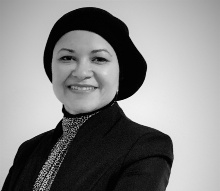What is your research focus?
My focus is on sustainable and intelligent approaches in architecture. One such approach is bio-based materials and renewable raw materials, for example straw. As an architect, I look for aesthetic concepts based on these materials and draw inspiration from them. Our research strategies in the BioMat department include function-oriented design methods, spatial configurations and bionically inspired structural forms, specialised material knowledge, digital fabrication and processing techniques, and collaboration with industry.
Which of nature's inventions do you admire the most?
There are many. One concept I worked on with my students is diatoms, small microorganisms that live under water. They have a great plug-in system that we took up to build a shell structure. This is a very good example of how the use of resources can be minimised. You also don't need any adhesives for the connections.
Which buildings in Stuttgart do you particularly like?
First and foremost for me is the intricate lightweight structure of Jörg Schlaich's observation tower on the grounds of the Höhenpark Killesberg. It was erected in 2001, but was already planned in the 1980s. This tower reflected a minimal use of materials in a beautiful supporting concept at a very early stage. But the Mercedes-Benz Museum and the Public Library also embody outstanding architecture.


